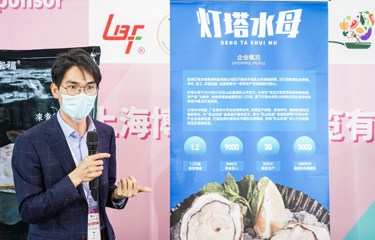With seafood imports headed into China delayed by an increased inspection regime, a young Chinese company is hoping to gain more share of the lucrative raw oyster market in the world’s most-populous country.
Weihai Lighthouse Jellyfish Marine Technology Co. Ltd. produces oysters in Rushan, Shandong Province, which has begun marketing itself as “the home of Chinese oysters – a campaign that earned the city a gold medal award at the 2020 China Trademark Branding Conference, organized by the China Trademark Association. In 2009, Rushan secured China’s geographic indicator (GI) for the city’s oysters and have since branded production under that GI.
For the most part, Rushan oyster output is focused on quantity, with more than 300,000 metric tons (MT) of annual production worth CNY 2.4 billion (USD 348 million, EUR 287 million), according to the city’s Ocean and Fisheries Bureau. The bulk of China’s oysters are used for sauces and roast oyster dishes, but demand is also growing for raw oysters, even though the market is currently dominated by imports from Western suppliers.
In an interview with SeafoodSource, Weihai Lighthouse Jellyfish CEO Hou Bin (who uses the English name Ben Hou) said his company is building a brand to compete against premium imported oysters in the growing domestic market. The company recently received an “Encourage Promotion Award” from the Aquaculture Stewardship Council, which recognized the firm as one of three Chinese aquaculture companies “showing progress towards ASC standards” and holding “special roles and contributions in responsible aquaculture.”
SeafoodSource: Are Chinese consumers willing to eat raw oysters? Or do they like cooked or grilled oysters?
Hou: In China, raw oysters are not the mainstream. More consumers like grilled oysters and steamed oysters. In Chinese night markets, garlic roasted oysters are very popular and they are the most accepted way of eating [oysters]. Next is steamed oysters, served with some ingredients. Of course, there are other different ways of eating in different places, such as fried oysters, oyster porridge, dried oysters, and so on. In general, there are many ways to eat oysters in China, but most of them are in the form of cooked food.
SeafoodSource: You want to compete with oysters imported from countries like France, which are very expensive in China?
Hou: Given the positioning of our mid- to high-end oyster products, our competition with French oysters will be inevitable. Foreign oyster industries such as the French oyster sector have developed [the Chinese market] over many years. There are many things we can learn from them. We will learn from the outstanding parts of them and form the characteristics and competitiveness of the Lighthouse Jellyfish. The prices of imported oysters such as French Gillardeau are indeed very high in China.
SeafoodSource: What is your biggest goal or aspiration for 2021?
Hou: We are still not sure whether domestic consumers can accept mid- to high-end oyster products, and whether they will show more demand and habits for edible oyster products in the future, but we will continue to work hard. In the future, as our high-end raw oyster purification center is completed and put into production, our oyster products will also be presented to consumers with a higher-quality image. Although people in China are not optimistic about the acceptance of oyster products, we still have belief.
Taking the mid- to high-end product route is something we are determined to do. This is also the inevitable trend of future development for Rushan oysters. We hope that through our efforts, more people can accept and recognize our oyster products. Not only that, we also hope that our raw oysters can go international in the future, so that more international friends can taste Chinese high-quality oyster products.
SeafoodSource: Why are the prices of French oysters so much higher than Chinese oysters?
Hou: French oysters are well-known internationally, and their quality is recognized by everyone. They are high-end oyster products. In addition, there will be additional costs in the process of transporting [oysters] to China. So the price will thus be relatively high. In China, people's acceptance of oysters is still in its infancy, and most oyster-producing companies do not have the awareness or [take the] actions to create high-end products. They often cater to the current consumer market for pricing and sales, so there is a large price difference. Compared with oysters from other regions in China, Rushan oysters have certain quality advantages. We are also constantly promoting the development of Rushan oysters towards the high-end oyster market through various improvements. This is why Rushan oysters are better than oysters from other regions in China. They are expensive, but there is still a certain gap compared to French oysters such as Gillardeau.
SeafoodSource: Who are your typical customers? Do your customers eat oysters at home or in restaurants?
Hou: The middle-class people who pursue quality are our ultimate target group. Now our products are more targeted at restaurants and ordinary consumers. Customers who buy our products through e-commerce platforms are often willing to cook their own oysters at home, but after all, opening oysters is a tedious task, so there are still a large number of people who are willing to directly taste the finished oysters through offline restaurants.
SeafoodSource: What is the biggest challenge you faced in 2020?
Hou: 2020 was a relatively difficult year. The epidemic has had a huge impact on many industries. In particular, China's oyster industry is in its infancy. We have made many adjustments and changes during the year. The most important thing is that we put more focus on the e-commerce platform. During this year, we have been trying to optimize the overall design of online products, not only the appearance is more refined, but also the details of user experience. We want to make our products different from other similar products on the market … more refined, more in line with consumer needs, more high-end oyster products.
Photo courtesy of Ben Hou/Weihai Lighthouse Jellyfish Marine Technology Co.







